
Wetenschap
Order up:nieuwe studie onthult het belang van vloeibare structurele ordening bij kristallisatie
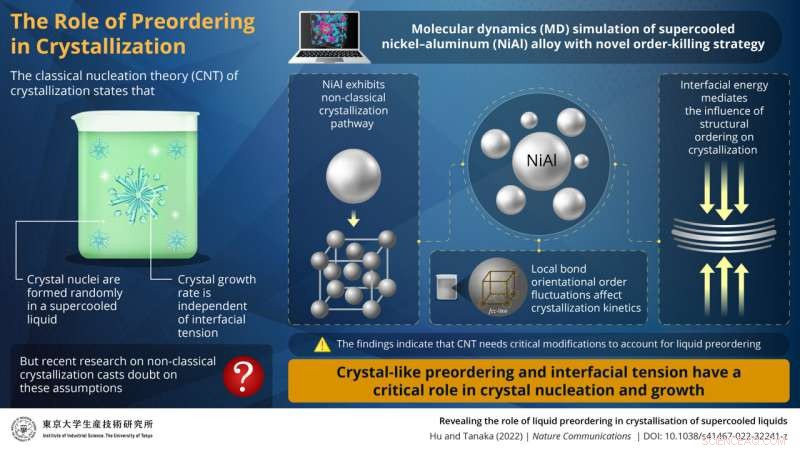
Moleculaire dynamische simulaties van een onderkoelde nikkel-aluminiumlegering onthullen dat kristalachtige pre-ordering en grensvlakspanning belangrijk zijn bij kristalkiemvorming en -groei, wat een kritieke leemte in de klassieke nucleatietheorie benadrukt. Credit:Hajime Tanaka van de Universiteit van Tokio
Kristallisatie in vloeistoffen is een fundamentele faseovergang. Terwijl het begrip van kristallisatie jarenlang werd bepaald door de klassieke nucleatietheorie, heeft recent onderzoek de focus verlegd naar niet-klassieke routes in kristallisatie. In een nieuwe studie onthullen wetenschappers van het Institute of Industrial Science, The University of Tokyo, dat de kristalprecursorstructuur, die zich spontaan vormt als een structurele fluctuatie in een onderkoelde vloeistof, een kritische invloed heeft op kristalkiemvorming en -groei.
Kristallisatie, de vorming van homogene, geordende vaste stoffen uit vloeistoffen, is een cruciaal proces op verschillende gebieden, variërend van atmosferische wetenschap tot farmaceutische producten tot de productie van halfgeleiders. Als zodanig is begrip van kristallisatie op moleculair niveau een kritisch onderzoeksgebied met brede toepasbaarheid. Al tientallen jaren wordt kristallisatie begrepen in termen van klassieke nucleatietheorie (CNT). CNT stelt dat microscopisch kleine vaste stoffen (kernen) zich willekeurig en spontaan uit de vloeistof vormen en beginnen te groeien tot een kristal zodra ze een bepaalde grootte overschrijden. Recenter onderzoek in het veld heeft echter aangetoond dat CNT niet altijd geldig is en dat niet-klassieke routes moeten worden onderzocht om het fenomeen van kristallisatie volledig te begrijpen.
Studies naar de structurele eigenschappen van glasvormende vloeistoffen (vloeistoffen die bij onderkoeling een niet-kristallijne, amorfe "vaste stof" vormen) hebben aangetoond dat, in tegenstelling tot de voorspellingen van CNT, kiemvorming niet willekeurig is. In plaats daarvan worden kristalkernen geïnduceerd in specifieke vooraf geordende gebieden van de onderkoelde vloeistof die lokale oriënterende symmetrie hebben die consistent is met het kristal. Bovendien heeft recent onderzoek naar snelle kristalgroei, dat niet kan worden voorspeld door CNT, twijfel doen rijzen over een van de fundamentele veronderstellingen van CNT:dat kristalgroeisnelheid onafhankelijk is van grensvlakspanning (de neiging van een vloeistof om een minimaal vrij oppervlak te hebben wanneer in contact met een andere niet mengbare vloeistof).
Om deze vragen over CNT te beantwoorden, heeft een onderzoeksteam van het Institute of Industrial Science, The University of Tokyo (UTokyo-IIS), zich verdiept in de rol van pre-ordering op kristalgroei en nucleatie. The research team consisted of Professor Emeritus Hajime Tanaka of the Research Center for Advanced Science and Technology, UTokyo (formerly from Utokyo-IIS) and Dr. Yuan-Chao Hu, Yale University (formerly from Utokyo-IIS). The study, published in Nature Communications , highlights critical shortcomings in CNT and proposes critical modifications to address them.
In this study, the research team performed extensive molecular dynamics (MD) simulations of a supercooled nickel-aluminum alloy (NiAl). "We found that NiAl follows a non-classical crystallization pathway and that structural fluctuations in the precursors of crystals dramatically influenced crystal growth," reveals Dr. Hu.
The research team then developed a novel "order-killing strategy" to suppress preordering. They found that the order-killing strategy successfully reduced crystallization rate over several orders of magnitude. "Preordering reduces interfacial energy," explains Prof. Tanaka. "Our findings indicate that preordering and its associated reduction in interfacial energy are critical to crystal nucleation and growth, which exposes an important gap in CNT."
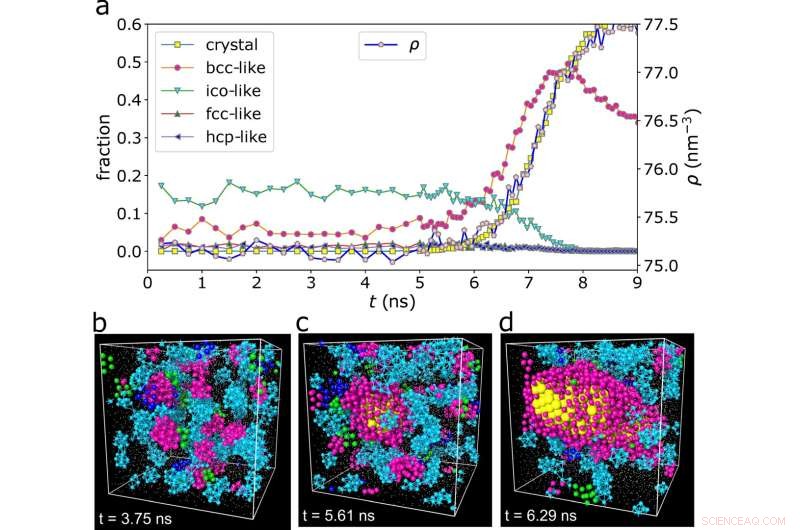
The figure depicts (a) the time-dependent fraction of crystallized atoms and their various structural orderings, indicating that crystal-like (here, bcc-like) preordering is a significant process in the growth of crystals. (b–d) show the different atomic configurations of the crystal at different times (t), indicating that preordering is transient and fluctuates in space, and that crystal nuclei are born from and grow from the crystal-like preordered regions. (c) highlights the critical nucleus in this condition. Credit:Hajime Tanaka from University of Tokyo
Prof. Tanaka and Dr. Hu then accounted for interfacial energy in their simulations by including an interfacial energy-related factor. They then evaluated the interfacial energy-related factor in eight different systems with different bonding types and crystal structures. "Our findings suggest that liquid preordering could be the most important contributor to crystallization kinetics and glass formation. This could have a significant ripple effect in both fundamental science and industrial applications," concludes Prof. Tanaka.
The findings of the study provide novel insights into crystallization kinetics. The implications of this study are sure to influence a wide-range of crystal-related applications, such as the control of silicon crystallization in the semi-conductor industry. + Verder verkennen
Liquid-liquid transitions crystallize new ideas for molecular liquids
 Siliconen verkregen bij lage temperaturen met behulp van lucht
Siliconen verkregen bij lage temperaturen met behulp van lucht Bestel op! AI vindt het juiste materiaal
Bestel op! AI vindt het juiste materiaal Dennennaalden van oude kerstbomen kunnen in de toekomst worden omgezet in verf en voedselzoetstoffen
Dennennaalden van oude kerstbomen kunnen in de toekomst worden omgezet in verf en voedselzoetstoffen Moleculaire files doorbreken met nanoporeuze materialen met vinnen
Moleculaire files doorbreken met nanoporeuze materialen met vinnen De warmtestroom in een vaste stof beheersen door de dimensionaliteit van de kristalstructuur te veranderen
De warmtestroom in een vaste stof beheersen door de dimensionaliteit van de kristalstructuur te veranderen
 Comeback Braziliaanse reuzen toont aan dat behoud en ontwikkeling van Amazon mogelijk is
Comeback Braziliaanse reuzen toont aan dat behoud en ontwikkeling van Amazon mogelijk is Expert roept op tot vuurlijn om toekomstbestendig te zijn tegen bosbranden
Expert roept op tot vuurlijn om toekomstbestendig te zijn tegen bosbranden Bodemonderzoek geeft aanwijzingen voor het oude klimaat
Bodemonderzoek geeft aanwijzingen voor het oude klimaat Om klimaatverandering te begrijpen, we moeten het weer nu begrijpen
Om klimaatverandering te begrijpen, we moeten het weer nu begrijpen Air India stopt met het gebruik van plastic voor eenmalig gebruik op vluchten
Air India stopt met het gebruik van plastic voor eenmalig gebruik op vluchten
Hoofdlijnen
- Roofzuchtige bacteriën die patrijspoorten maken en fresco's schilderen in schadelijke bacteriën
- Kikkers onthullen mechanisme dat de levensvatbaarheid van hybriden bepaalt
- Prolifereren of niet prolifereren? Een cellulaire lente antwoordt
- Vleugelafdrukken kunnen individuele vleermuizen net zo effectief identificeren als vingerafdrukken mensen identificeren
- Spanje meldt geval van gekkekoeienziekte
- Wat is het pad van het licht door het oog?
- Onderwaterhitte inferno verwoest mediterrane koralen
- Schimmel is afhankelijk van bacteriën om de belangrijkste componenten van zijn voortplantingsmechanisme te reguleren
- Hoe Body Dysmorphic Disorder werkt
- Primordiale zwarte gaten hebben mogelijk geholpen bij het smeden van zware elementen
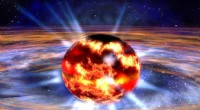
- Wetenschappers maken diodes gemaakt van licht
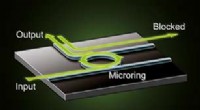
- Wetenschappers melden opmerkelijke verbetering van clustering van α-deeltjes in uraniumisotopen
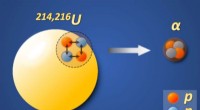
- Welke planeten zijn de gasplaneten?

- Geen storm in een kopje thee:het is een cycloon op een siliciumchip

 Macromoleculaire kristallografie werpt licht op een nieuwe manier om de malariaparasiet aan te pakken
Macromoleculaire kristallografie werpt licht op een nieuwe manier om de malariaparasiet aan te pakken Hoe Amerikaans racisme geworteld is in residentiële segregatie
Hoe Amerikaans racisme geworteld is in residentiële segregatie LHCb-experiment kondigt waarneming aan van een nieuw deeltje met twee zware quarks
LHCb-experiment kondigt waarneming aan van een nieuw deeltje met twee zware quarks Na inschrijvingsdips, openbare scholen hopen op herstel van de herfst
Na inschrijvingsdips, openbare scholen hopen op herstel van de herfst Een kankervernietigersubstantie met nieuw werkingsmechanisme gevonden
Een kankervernietigersubstantie met nieuw werkingsmechanisme gevonden Grenzen van atoomkernen voorspeld:wetenschappers simuleren een groot deel van de kaart met nucliden
Grenzen van atoomkernen voorspeld:wetenschappers simuleren een groot deel van de kaart met nucliden Je ware zelf zijn wordt niet altijd gelijk behandeld in de zakenwereld, nieuwe studie vondsten
Je ware zelf zijn wordt niet altijd gelijk behandeld in de zakenwereld, nieuwe studie vondsten De aarde was gestrest vóór het uitsterven van dinosauriërs
De aarde was gestrest vóór het uitsterven van dinosauriërs
- Elektronica
- Biologie
- Zonsverduistering
- Wiskunde
- French | Italian | Spanish | Portuguese | Swedish | German | Dutch | Danish | Norway |

-
Wetenschap © https://nl.scienceaq.com

